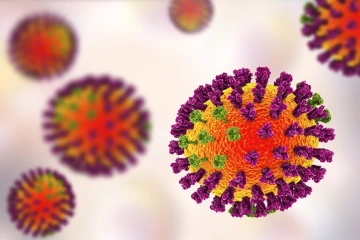Boost Your Immunity with the Flu Vaccine
There are many ways to protect yourself against flu, such as avoiding close contact with people who are sick, washing your hands, and avoiding touching your eyes, nose and mouth.

It’s fall, which means flu season has begun. Seasonal influenza (flu) viruses lurk year-round, but circulation ramps up in the fall and peaks during the winter. Luckily, there are many ways to protect yourself against flu, such as avoiding close contact with people who are sick, washing your hands, and avoiding touching your eyes, nose and mouth. In addition to practicing those healthy habits — which can protect you from other bugs as well — you can obtain a flu vaccine, which teaches your immune system to recognize common flu viruses and attack them before they can do damage.
Immune cells march through our bloodstreams, on the lookout for invaders. These immune cells come in two flavors: innate and adaptive.
“The innate immune system is your first line of defense,” explains Michael Kuhns, PhD, associate professor of immunobiology at the UA College of Medicine – Tucson. “These cells are sentinels, and they’re always at the ready in the event that you have a cut or some other insult that allows a pathogen into your body.”
Innate immune cells are generalists — jacks of all trade that can offer immediate, but nonspecific, protection from bugs. They include macrophages, eating machines that roam the bloodstream, gulping down and digesting germs. They leave behind pieces of these invaders called “antigens.”
And this is where the adaptive immune system’s job begins.

Because it takes the immune system a couple of weeks to manufacture antibodies, you might get sick before your immune system can bring the infection under control.
Adaptive immune soldiers called B cells use the antigens left by macrophages as templates to design custom-made antibodies. The next time that bug attacks, the immune system recognizes its antigens and deploys those antibodies, which attach to the pathogens and flag them for destruction by T cells. The adaptive immune system performs its tasks under the supervision of “helper” T cells called CD4 cells.
“CD4 T cells are like the field generals of the immune system,” Dr. Kuhns says. “They direct B cells to go out and make antibodies, and they direct killer T cells to go out and kill.”
Because it takes the immune system a couple of weeks to manufacture antibodies, you might get sick before your immune system can bring the infection under control. That’s where vaccines like the flu shot come in. They give your immune system a sneak preview of a dangerous bug’s antigens, allowing it to create antibodies ahead of time. That way, instead of waiting two weeks, it can spring into action the instant that bug is detected.

Seasonal flu vaccines are reformulated every year to provide protection against the flu viruses predicted to predominate that season.
Each year the flu vaccine prevents millions of illnesses and tens of thousands of hospitalizations. It’s not 100% effective, but it reduces the risk of catching the flu and can decrease the severity of symptoms if you do catch it. UA students can receive a flu shot at UA Campus Health, employees can obtain free flu shots through Life & Work Connections, and anyone can get the vaccine at drugstores, the health department or other clinics — click here to find a flu shot near you. If you don’t have insurance, the out-of-pocket cost could be in the ballpark of $20 to $40.
About the Author
The University of Arizona Health Sciences is the statewide leader in biomedical research and health professions training. The UArizona Health Sciences includes the UArizona Colleges of Medicine (Phoenix and Tucson), Nursing, Pharmacy, and Mel and Enid Zuckerman College of Public Health, with main campus locations in Tucson and the growing Phoenix Biomedical Campus in downtown Phoenix.

